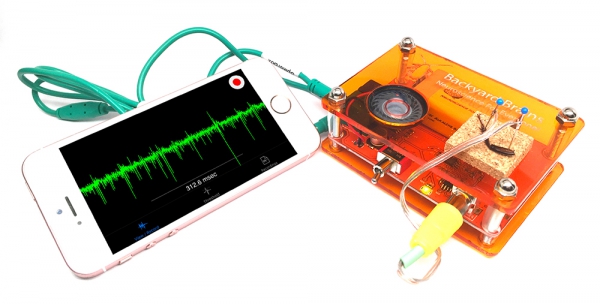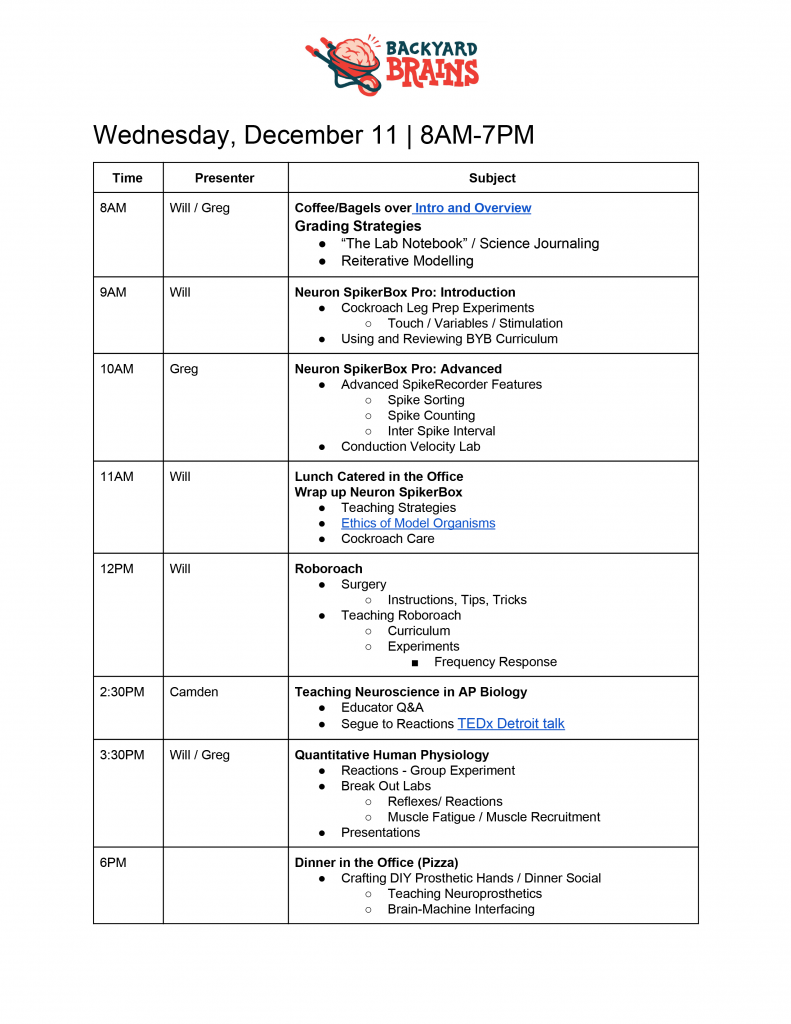-
 BizHow the SpikerBox Revolutionized K12 STEM Education… and just what is a SpikerBox? Backyard Brains exists today because of a once-lofty goal: To turn a $40,000+ rack of graduate-level electronics into a $100 kit that students could use in the classroom to perform real, hands-on neuroscience experiments. A decade later, we have developed four lines of products […]
BizHow the SpikerBox Revolutionized K12 STEM Education… and just what is a SpikerBox? Backyard Brains exists today because of a once-lofty goal: To turn a $40,000+ rack of graduate-level electronics into a $100 kit that students could use in the classroom to perform real, hands-on neuroscience experiments. A decade later, we have developed four lines of products […] -
 BizFollowing the previous success of our 3-day Teacher Training workshop at the end of the 2019 Calendar Year – we decided to kick-off 2020 with a free workshop for educators, open to all! So we set a date… Jan 31st, shot out some emails, and hoped we wouldn’t be eating bagels and cream cheese alone in […]
BizFollowing the previous success of our 3-day Teacher Training workshop at the end of the 2019 Calendar Year – we decided to kick-off 2020 with a free workshop for educators, open to all! So we set a date… Jan 31st, shot out some emails, and hoped we wouldn’t be eating bagels and cream cheese alone in […] -
 EducationWould you like all the benefits of a Backyard Brains workshop without leaving the comfort of your desk chair? Our friends and partners at Educational Innovations can help! On February 20, 2020, from 4:00-4:30pm EST, Educational Innovations will be hosting a webinar on Neuroscience in the K-12 Classroom! The Details…What: a free, 30-minute webinar from EI […]
EducationWould you like all the benefits of a Backyard Brains workshop without leaving the comfort of your desk chair? Our friends and partners at Educational Innovations can help! On February 20, 2020, from 4:00-4:30pm EST, Educational Innovations will be hosting a webinar on Neuroscience in the K-12 Classroom! The Details…What: a free, 30-minute webinar from EI […] -
 BizNeuroscience Experiment Intern Wanted (Downtown Ann Arbor) Compensation: $15/hr based on 40-hour work weekEmployment type: full-time internship Backyard Brains is seeking a neuroscience intern to continue ongoing experiments! You:-A STEM undergrad, currently taking a break from the classroom. (Recent grad or gap year preferable)-Passionate about scientific discovery and designing innovative, impactful experiments-Experienced in or excited by a future […]
BizNeuroscience Experiment Intern Wanted (Downtown Ann Arbor) Compensation: $15/hr based on 40-hour work weekEmployment type: full-time internship Backyard Brains is seeking a neuroscience intern to continue ongoing experiments! You:-A STEM undergrad, currently taking a break from the classroom. (Recent grad or gap year preferable)-Passionate about scientific discovery and designing innovative, impactful experiments-Experienced in or excited by a future […] -
 EducationTexas Teachers Brave Michigan Winter for Neuroscience Ed Workshop, and Love it! Nine teachers from Texas join up with a few of us Neuroscience Education nerds in snowy Michigan… and holiday magic happens!
EducationTexas Teachers Brave Michigan Winter for Neuroscience Ed Workshop, and Love it! Nine teachers from Texas join up with a few of us Neuroscience Education nerds in snowy Michigan… and holiday magic happens! -
 EducationThis past summer, we worked with teachers and educators during a number of workshops to help empower them to bring DIY Neuroscience to their classrooms. One workshop, hosted by one of our colleagues at University of Chicago, brought Backyard Brains tools and training to 7th grade teachers in the Chicago area. Taken from the National Center […]
EducationThis past summer, we worked with teachers and educators during a number of workshops to help empower them to bring DIY Neuroscience to their classrooms. One workshop, hosted by one of our colleagues at University of Chicago, brought Backyard Brains tools and training to 7th grade teachers in the Chicago area. Taken from the National Center […] -
 EducationThe Leadership Initiatives Advanced Medical Neuroscience Summit is a program that’s available for rising freshmen in high school to rising freshmen in college that gives students the opportunity to live for a short time at a college campus (Gorgeous Georgetown), attend lectures and learn from neuroscience professors, tour high-tech labs, and perform hands-on research. This […]
EducationThe Leadership Initiatives Advanced Medical Neuroscience Summit is a program that’s available for rising freshmen in high school to rising freshmen in college that gives students the opportunity to live for a short time at a college campus (Gorgeous Georgetown), attend lectures and learn from neuroscience professors, tour high-tech labs, and perform hands-on research. This […] -
 EducationYou never know what might capture a students’ attention and passion… Maybe the recent photo of a black hole inspires a student to learn about astrophysics, or maybe an experiment involving cockroaches inspires a student to want to learn more about neuroscience! Recently, we heard word from two graduating high school seniors in Ohio who started […]
EducationYou never know what might capture a students’ attention and passion… Maybe the recent photo of a black hole inspires a student to learn about astrophysics, or maybe an experiment involving cockroaches inspires a student to want to learn more about neuroscience! Recently, we heard word from two graduating high school seniors in Ohio who started […] -
 EducationDr. Katie Wilkinson, a Neurophysiologist from San Jose State University, worked with her seniors to incorporate neuroscience and Backyard Brains equipment into their labs. She recently tweeted about her students and the very first Neurophysiology Lab Best Poster Award that they were competing against each other for, posters and projects which used BYB equipment to […]
EducationDr. Katie Wilkinson, a Neurophysiologist from San Jose State University, worked with her seniors to incorporate neuroscience and Backyard Brains equipment into their labs. She recently tweeted about her students and the very first Neurophysiology Lab Best Poster Award that they were competing against each other for, posters and projects which used BYB equipment to […] -
 EducationIt takes a practiced hand to be able to take complex, abstract ideas, and describe them in simple ways. In many ways, this is the job of educators. We take it upon ourselves to grapple with abstractions and find novel connections, comparisons, and metaphors to help others understand a new idea. Brod Bagert, who we met […]
EducationIt takes a practiced hand to be able to take complex, abstract ideas, and describe them in simple ways. In many ways, this is the job of educators. We take it upon ourselves to grapple with abstractions and find novel connections, comparisons, and metaphors to help others understand a new idea. Brod Bagert, who we met […] -
 EducationIt can’t be avoided: the standards must be met! While we encourage educators everywhere to break free from the shackles of bureaucratic granularity in education… we also admit that education standards perform a necessary function. There are educational and developmental milestones that all students should achieve, and it is the goal of the standards to […]
EducationIt can’t be avoided: the standards must be met! While we encourage educators everywhere to break free from the shackles of bureaucratic granularity in education… we also admit that education standards perform a necessary function. There are educational and developmental milestones that all students should achieve, and it is the goal of the standards to […] -
 EducationNeuroscience Education creates Excitement, engenders Empathy, and inspires Exploration A quick introduction: Amy Farkas is a Middle School STEM teacher from Southeastern Michigan who sought and won funding for her class’s foray into Neuroscience. She then spent the last quarter of her school year this past year introducing her students to Neuroscience and Biomedical Sciences. These are […]
EducationNeuroscience Education creates Excitement, engenders Empathy, and inspires Exploration A quick introduction: Amy Farkas is a Middle School STEM teacher from Southeastern Michigan who sought and won funding for her class’s foray into Neuroscience. She then spent the last quarter of her school year this past year introducing her students to Neuroscience and Biomedical Sciences. These are […]